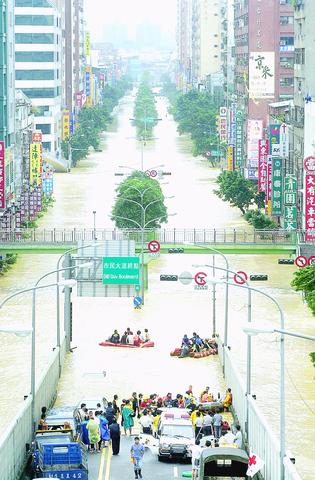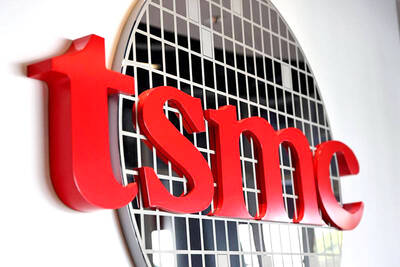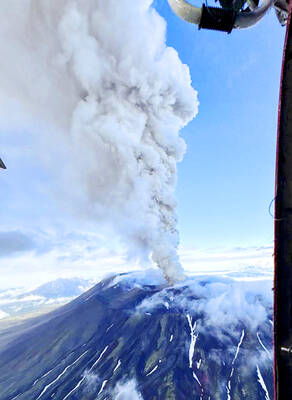Typhoon Nari pounded northern Taiwan yesterday, leaving as many as 34 people dead and families searching for missing relatives.
Across the nation, 94 people were reported injured as of press time last night.

PHOTO: LIAO RAY-SHANG, TAIPEI TIMES
More than 800,000 Taipei area families were left in the dark after the typhoon cut electricity supplies. Another 300,000 were left without a dial tone.
In addition to disrupted train and flight schedules, Taipei's mass rapid transit system was completely shut down due to heavy flooding at some stations along the Nankang-Panchiao line.
Nari, the 16th typhoon of the year and the third to make landfall, was expected to leave Taiwan at around 2pm today, moving in a south-westerly direction from Chiayi County.
The typhoon's heavy rainfall has resulted in the worst flooding in the greater Taipei area in 50 years.
According to the National Fire Administration, waters in some parts of Hsihchih in Taipei County rose three stories high. In Keelung the flooding was one story high.
Some low-lying areas in Taipei City were also flooded. They included the Neihu, Wenshan, Shihlin, Nankang, Hsinyi and Chungshan districts.
As of midnight, in Taipei City 16 people were reported dead and 80 injured, according to the National Fire Administration. In Taipei County, 10 people were reported dead while eight people were reported dead in Keelung. Others were still missing.
George Lu (呂國臣), a meteorologist at the Central Weather Bureau, said that Nari -- already dubbed the "weirdest storm in Taiwan's history" because of its unpredictable path -- broke many records in terms of its course, the duration of its stay and the amount of rainfall it delivered.
"While most typhoons travel in either a parabolic curve or straight line, Typhoon Nari trailed on a bow-shaped course back and forth in the Pacific Ocean," Lu said.
Lu added that it was because the typhoon traveled at such a slow speed -- 4kph to 6kph -- that a substantial amount of rainfall was recorded during its 40-hour visit.
"While the previous highest daily amount of rainfall in Taipei City was recorded at 358mm, we saw over 400mm yesterday alone," Lu said. "And while most typhoons linger for between 11 and 12 hours after making landfall, Nari has stayed for over 19 hours now," he said at about 5pm yesterday.
Inspecting one of the hardest hit areas in Hsichih, Premier Chang Chun-hsiung (張俊雄) called on other areas spared by the typhoon to help in relief efforts.
"We have mobilized the military to help in the relief efforts, and we definitely need more help from the public," Chang said.
Taipei City Mayor Ma Ying-jeou (
"I also call on the public to be patient with the city's efforts in pumping out water, because we have only a limited number of water pumps," Ma said.
Ma said the cause of yesterday's flooding was primarily the result of the extremely heavy rainfall rather than poor city infrastructure.
"I know it's not fair to say so because there's still plenty of room for improvement in the city's sewage system, but it's true that the city has never seen so much rainfall in one day," Ma said.

Authorities have detained three former Taiwan Semiconductor Manufacturing Co (TMSC, 台積電) employees on suspicion of compromising classified technology used in making 2-nanometer chips, the Taiwan High Prosecutors’ Office said yesterday. Prosecutors are holding a former TSMC engineer surnamed Chen (陳) and two recently sacked TSMC engineers, including one person surnamed Wu (吳) in detention with restricted communication, following an investigation launched on July 25, a statement said. The announcement came a day after Nikkei Asia reported on the technology theft in an exclusive story, saying TSMC had fired two workers for contravening data rules on advanced chipmaking technology. Two-nanometer wafers are the most

NEW GEAR: On top of the new Tien Kung IV air defense missiles, the military is expected to place orders for a new combat vehicle next year for delivery in 2028 Mass production of Tien Kung IV (Sky Bow IV) missiles is expected to start next year, with plans to order 122 pods, the Ministry of National Defense’s (MND) latest list of regulated military material showed. The document said that the armed forces would obtain 46 pods of the air defense missiles next year and 76 pods the year after that. The Tien Kung IV is designed to intercept cruise missiles and ballistic missiles to an altitude of 70km, compared with the 60km maximum altitude achieved by the Missile Segment Enhancement variant of PAC-3 systems. A defense source said yesterday that the number of

A bipartisan group of US representatives have introduced a draft US-Taiwan Defense Innovation Partnership bill, aimed at accelerating defense technology collaboration between Taiwan and the US in response to ongoing aggression by the Chinese Communist Party (CCP). The bill was introduced by US representatives Zach Nunn and Jill Tokuda, with US House Select Committee on the Chinese Communist Party Chairman John Moolenaar and US Representative Ashley Hinson joining as original cosponsors, a news release issued by Tokuda’s office on Thursday said. The draft bill “directs the US Department of Defense to work directly with Taiwan’s Ministry of National Defense through their respective

Tsunami waves were possible in three areas of Kamchatka in Russia’s Far East, the Russian Ministry for Emergency Services said yesterday after a magnitude 7.0 earthquake hit the nearby Kuril Islands. “The expected wave heights are low, but you must still move away from the shore,” the ministry said on the Telegram messaging app, after the latest seismic activity in the area. However, the Pacific Tsunami Warning System in Hawaii said there was no tsunami warning after the quake. The Russian tsunami alert was later canceled. Overnight, the Krasheninnikov volcano in Kamchatka erupted for the first time in 600 years, Russia’s RIA